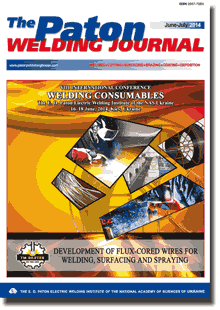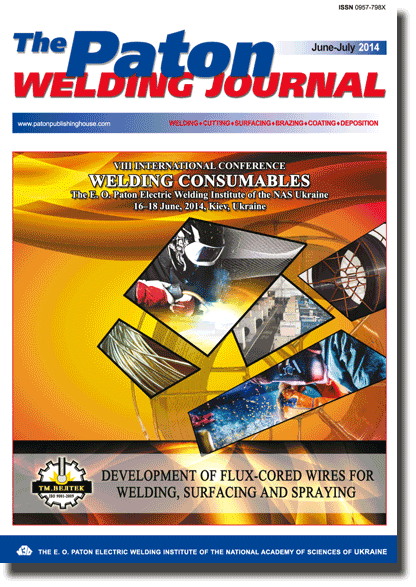| 2014 №06 (07) |
DOI of Article 10.15407/tpwj2014.06.08 |
2014 №06 (09) |

The Paton Welding Journal, 2014, #6-7, 40-45 pages
UNDERWATER WELDING AND CUTTING IN CIS COUNTRIES
V.Ya. KONONENKO
E.O. Paton Electric Welding Institute, NASU. 11 Bozhenko Str., 03680, Kiev, Ukraine. E-mail: office@paton.kiev.ua
Abstract
At the present time there are two main types of welding works under water: hyperbaric dry welding and wet welding. Both methods are successfully applied at the territory of CIS countries for repair and construction of metal structures under water. Hyperbaric dry welding is the most demanded in cases of repair works at underwater gas pipelines passages across water barriers, because it provides high predicted level of mechanical properties of welded joints. Wet welding is demanded at construction and repair of hydrotechnical objects such as berths, basements of extracting platforms and also at lifting and emergency repair of ships and vessels. For its fulfillment the covered electrodes and mechanized welding process using self-shielding flux-cored wires are used. The mechanical properties of welded joints, which are provided by these technologies, are at the level of mechanical properties of joints produced in welding in air using electrodes of the type E42 and E46. However during realization of these technologies there is a possibility of defect formation caused by a sharp cooling of weld metal and human factor during work of a diver-welder under water. At the present time to perform underwater cutting the most challenging are the technologies of underwater electric-oxygen cutting and cutting using exothermal electrodes, which are produced both at the territory of CIS countries as well as beyond their borders. These technologies provide comparatively low level of productivity and necessity of additional mechanical treatment of the cutting zone in case of the further producing of welded joints. Using dry and wet welding at the territory of CIS countries a great volume of works was performed connected with repair of underwater pipelines, berth erections, lifting and repair of ships and vessels. The most significant work at the recent time was performed in construction of off-shore ice-resistant stationary platform «Prirazlomnaya». 9 Ref., 3 Tables.
Keywords: dry underwater welding, wet welding, covered electrodes, flux-cored wires, mechanical properties of joints, performed works
Received: 22.04.14
Published: 28.09.14
References
1. Paton, B.E., Savich, I.M. (1987) To the 100th anniversary of underwater welding. Avtomatich. Svarka, 12, 1-2.
2. Evans, N.H. (1974) Welding in offshore constructions. Metal Constr. and British Welding J., 5, 153-157.
3. Kononenko, V.Ya. (2011) Underwater welding and cutting. Kiev: Ukraina.
4. Kononenko, V.Ya. (2010) Application of method of dry underwater welding in repair of underwater passages of gas and oil pipelines in Russia. The Paton Welding J., 5, 42-46.
5. Savich, I.M. (1969) Flux-cored wire underwater welding. Avtomatich. Svarka, 10, 70.
6. Kononenko, V.Ya. (2004) Technology of underwater welding and cutting. Kiev: Ekotekhnologiya.
7. Kononenko, V.Ya. (2005) Technology of wet mechanized welding in construction of IRSSP «Prirazlomnaya». The Paton Welding J., 9, 33-35.
8. Kononenko, V.Ya. (2006) Technologies of underwater wet welding and cutting. Kiev, PWI.
9. Kononenko, V.Ya. (2005) Application of the technology of mechanized underwater welding in construction of OIRSP «Prirazlomnaya». The Paton Welding J., 12, 47.
Suggested Citation
V.Ya. KONONENKO (2014) UNDERWATER WELDING AND CUTTING IN CIS COUNTRIES. The Paton Welding J., 06, 40-45.The cost of subscription/purchase order journals or individual articles
| Journal/Currency | Annual Set | 1 issue printed |
1 issue |
one article |
| TPWJ/USD | 384 $ | 32 $ | 26 $ | 13 $ |
| TPWJ/EUR | 348 € | 29 € | 24 € | 12 € |
| TPWJ/UAH | 7200 UAH | 600 UAH | 600 UAH | 280 UAH |
| AS/UAH | 1800 UAH | 300 UAH | 300 UAH | 150 UAH |
| AS/USD | 192 $ | 32 $ | 26 $ | 13 $ |
| AS/EUR | 180 € | 30 € | 25 € | 12 € |
| SEM/UAH | 1200 UAH | 300 UAH | 300 UAH | 150 UAH |
| SEM/USD | 128 $ | 32 $ | 26 $ | 13 $ |
| SEM/EUR | 120 € | 30 € | 25 € | 12 € |
| TDNK/UAH | 1200 UAH | 300 UAH | 300 UAH | 150 UAH |
| TDNK/USD | 128 $ | 32 $ | 26 $ | 13 $ |
| TDNK/EUR | 120 € | 30 € | 25 € | 15 € |
AS = «Automatic Welding» - 6 issues per year;
TPWJ = «PATON WELDING JOURNAL» - 12 issues per year;
SEM = «Electrometallurgy Today» - 4 issues per year;
TDNK = «Technical Diagnostics and Non-Destructive Testing» - 4 issues per year.


